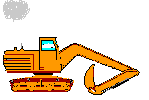 Link
Height: It is important to get a link number off the side of your link before
evaluating your measurements. Be sure all surfaces are clean, as little as 1/10 of
an inch in error makes a BIG difference. |
 Roller
Height: What you are after is the measurement of the diameter of the wear
surface. This measurement technique lets you measure the roller while it is still on
the machine. Measure "B" and subtract the link height. The result is
the radius of the worn surface so multiply times 2 to get the diameter.
2(B-C)=Diameter |
 Pitch:
(internal wear, sometimes called "stretch") is found by measuring across 5 track
pins, center too center. Make sure your tracks are tight (See Hints below)
Divide the measure you came up with by 4, and you have a comparison figure to correspond
with what your pitch was when new. |
 Idler
Wear: In this exercise you are trying to determine how worn your wear surfaces are
when compared to new. You want the distance from the top of the center guiding ridge
to the lowest point on your wear surfaces. They should not be dished or concave. |

Grouser Height: Make sure the tracks
are straight and pads are level when measuring. |

Carrier Roller:
You want to measure the diameter of the wear surfaces. Measure where they are the
most worn. The wear surfaces should not be dished or concave and should not have any
flat spots. The flanges should be repaired as needed. Check for bearing
tightness.
|

